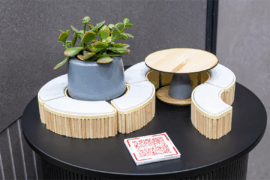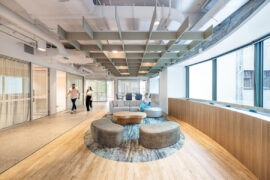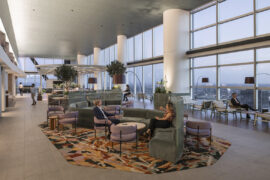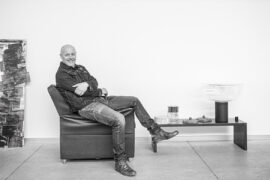You’re an intelligent and efficient worker, so why should your task furniture be any different?
All too often, the best and brightest workers are hampered by unresponsive, outdated office equipment that fails to respond to changing workplace habits. However, thanks to Melbourne monitor arm designers Zgonic, this may soon no longer be the case. Since 2011, Zgonic has been on an ongoing quest for innovation in monitor arms, developing solutions that are revolutionising the way we use our computers at work.
Today, offices purchase more monitors than desktop computers annually, and display solutions featuring multiple screens are on the rise. It is becoming increasingly common to see workers using two or more screens at once, if not working on a tablet or laptop. Yet with all this change comes new problems: the centrality of screen-based systems to the modern workplace has sparked a global epidemic of back pain. Approximately 80% of people will experience back pain at some stage in their lives, usually as a by-product of years of spending their workday in largely seated and sedentary environments. It’s a startling statistic, and one that Zgonic is doing their best to change.
Driven by core values of modularity, dynamism, flexibility, and uniqueness, Zgonic is redefining the playing field for monitor arms. The Zgonic name has become synonymous with striking, highly functional design that encourages good ergonomics and reduces back stress; in 2012, the flagship Zgo monitor arm was the recipient of a Gold Award in the Architectural and Interior category of the Australian International Design Awards.
Thanks to a rigorous R+D process, the Zgonic brand has become synonymous with outstanding design, flexibility, and ergonomic performance. Independent testing of Zgo by biomedical researchers dorsaVi showed that when used in conjunction with an ergonomic task chair, Zgo allows for a neutral sitting posture with an ideal flexion angle between the pelvis and lower spine. In a practical sense, this translates into Zgo helping you achieve ideal seated posture when working at your desk, significantly reducing your risk of back pain when compared with a standard monitor and task chair combination.
The latest addition to the Zgonic product family, Z1, delivers the same high level of performance, combining all the tried and tested technology of Zgo in a svelte, lightweight form. Designed to accommodate lightweight monitors weighing up to 5kg, Z1 is perfectly counterbalanced to offset the monitor weight without the need for fussy spring adjustment or tweaking. Simple plug-and-play, tool-free installation means that all you need to do is clamp Z1 to your desk and attach your monitor – just like that; you’re ready to work, without needing so much as a screwdriver. Using a tablet or laptop instead of a monitor? No problem – a tray attachment snaps into Z1 in a matter of seconds, and gives you full, secure control of your device’s position.
As a result of Z1’s highly responsive design, adjusting your screen has never been easier or had such a wide range of movement. Multi-axes adjustment capabilities give you full control of the height, tilt, and angle of the screen, granting you the freedom to arrange your screen at the viewing angle that is optimal for you and your stature and posture. A fully integrated, self-assisted spring mechanism makes moving the arm a breeze, requiring little more than a gentle push with the fingertips.
None of this impressive functionality is to say that Z1 makes any sacrifices when it comes to style. Like all Zgonic products, Z1’s playful nature shines through in a clean, contemporary form and bright colour palette. Magnetic panels on the side of Zi are available in 6 bold colours, providing a unique opportunity to complement workplace colour schemes or add a fresh pop of colour to a neutral space. The Z1 frame itself is available in a minimal, classic palette of silver, white, and black, and the entire unit comprises 29% recycled and 99% recyclable content. To keep things tidy and eliminate the hazards of cable interference, monitor cables can be secured neatly along Z1’s body by discreet, integrated hooks.
Clean, contemporary, and determined to make work-related back pain a thing of the past, Z1 is a powerful example of the potential for considered design to directly and positively impact on health. What’s more, Z1 reaffirms that good things need not come in big packages: it’s often the little things that really count.
INDESIGN is on instagram
Follow @indesignlive
A searchable and comprehensive guide for specifying leading products and their suppliers
Keep up to date with the latest and greatest from our industry BFF's!

For a closer look behind the creative process, watch this video interview with Sebastian Nash, where he explores the making of King Living’s textile range – from fibre choices to design intent.

From the spark of an idea on the page to the launch of new pieces in a showroom is a journey every aspiring industrial and furnishing designer imagines making.

Merging two hotel identities in one landmark development, Hotel Indigo and Holiday Inn Little Collins capture the spirit of Melbourne through Buchan’s narrative-driven design – elevated by GROHE’s signature craftsmanship.

Milliken’s ‘Reconciliation Through Design’ initiative is amplifying the voices of Aboriginal and Torres Strait Islander artists, showcasing how cultural collaboration can reshape the design narrative in commercial interiors.

Designed by Woods Bagot, the new fit-out of a major resources company transforms 40,000-square-metres across 19 levels into interconnected villages that celebrate Western Australia’s diverse terrain.

In an industry where design intent is often diluted by value management and procurement pressures, Klaro Industrial Design positions manufacturing as a creative ally – allowing commercial interior designers to deliver unique pieces aligned to the project’s original vision.

The Simple Living Passage marks the final project in the Simple World series by Jenchieh Hung + Kulthida Songkittipakdee of HAS design and research, transforming a retail walkway in Hefei into a reflective public space shaped by timber and movement.
The internet never sleeps! Here's the stuff you might have missed

We caught up with Abramo Manfrotto, CEO of Venetian decorative lighting brand LEUCOS, during a visit to Australia with dedece.

Located in the former Madam Brussels rooftop, Disuko reimagines 1980s Tokyo nightlife through layered interiors, bespoke detailing and a flexible dining and bar experience designed by MAMAS Dining Group.